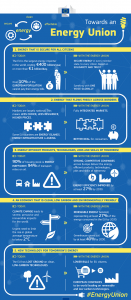This past week the European Commission adopted a series of policy objectives towards designing a more integrated European energy system that would entail less dependence on foreign imports and fewer carbon emissions. More specifically, three documents were issued by the Commission on 25 February 2015 to advance work on the Energy Union, a project figuring prominently on the Juncker Commission’s agenda and pursued by Maroš Šefčovič, the Vice-President responsible for the Energy Union and Miguel Arias Cañete, Commissioner for Climate Action and Energy. These documents are: (1) a “Framework Strategy for a Resilient Energy Union with a Forward-Looking Climate Change Policy”, (2) a blueprint for the global climate deal to be reached in Paris in December 2015 and the EU’s contribution towards it, and (3) a plan for achieving the current 10% target in electricity interconnections between the EU member states. All three increase the involvement of the European Commission in the work of member states to achieve a European Energy Union.
 The Framework Strategy lays out some 40 actions to be taken in the next two years, mostly by the European Commission but often requiring member state and European Parliament approval. The Commission hopes that these actions will help to diversify Europe’s current energy sources and make the EU shift from being the world’s largest energy importer to being the world’s leader in renewable energy production.
The Framework Strategy lays out some 40 actions to be taken in the next two years, mostly by the European Commission but often requiring member state and European Parliament approval. The Commission hopes that these actions will help to diversify Europe’s current energy sources and make the EU shift from being the world’s largest energy importer to being the world’s leader in renewable energy production.
Key steps include:
- intensify work on the Southern Gas Corridor to import gas from Central Asian countries
- set up liquid gas hubs in Northern Europe
- continue financing renewable energy projects
- begin work on a strategy for liquefied natural gas to lower its price
A revitalized EU external energy policy and climate diplomacy will back all this up by upgrading the strategic partnership on energy with Ukraine and by fostering such partnerships with Algeria, Turkey, Azerbaijan, Turkmenistan, the Middle East and Africa. Partnerships with Norway, as well as with the US and Canada, will also be developed further, with a view to reducing the dependence on any single supplier, notably Russia. Additionally, to reduce electricity prices, the EC hopes to interconnect Europe’s grids and develop new grid technologies such as energy storage, smart grids, and high voltage long distance connections.
The proposed plan looks good on paper, but many are skeptical that the EU will deliver. Among other things, the proposal to grant broader supervisory powers and independence to the EU Agency for the Cooperation of Energy Regulators (ACER) is expected to prove quite controversial. Moreover, nuclear energy, already viewed differently by EU member states, is only vaguely mentioned in the Commission’s Framework.
A meeting of energy ministers is expected to break down the Commission’s proposals into a series of measures acceptable to member states before a formal position is agreed upon at the Energy Council in June 2015. Other measures not included in the Framework but already forming part of the EU’s energy project range from new legislation to achieve a 40% reduction in greenhouse gas emissions by 2030 to a programme (Smart Financing for Smart Buildings) aimed at making buildings use energy more efficiently to a progressive switch from traditional fuels to alternative ones in the transport system.


